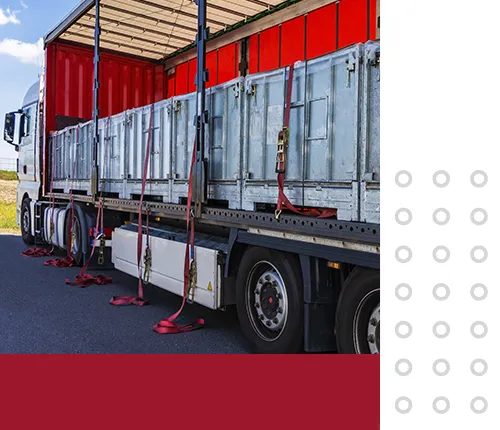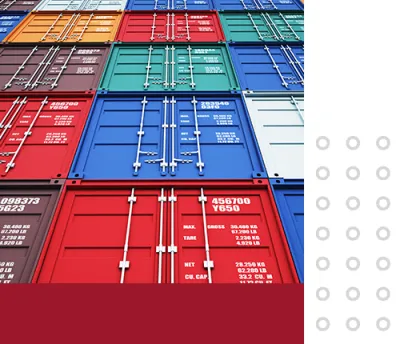04/11/2024

Loading containers – Everything you need to know
Loading containers is a key step in international trade, especially when using overseas containers for transporting goods . To ensure the cargo reaches its destination safely and efficiently, certain regulations must be observed during container loading and unloading – effective cargo securing must be ensured within the containers. In this article, we will discuss the most important aspects for optimal container loading and unloading .
Regulations for loading containers
When loading containers, there are specific regulations that are important for the safety of both the transport and the cargo. This includes ensuring even weight distribution to prevent the container from tipping or slipping during transport.
- Observe weight limits : It is important not to exceed the maximum permissible load. This applies not only to the total weight but also to the load distribution within the container.
- Safety regulations : The load must be properly secured to prevent slipping during transport. This includes lashing and the use of anti-slip mats.
- Who is authorized to load containers? In principle, anyone with appropriate training and the necessary knowledge is authorized to load a container. Employees should be trained in the regulations and safety measures to properly secure the load and prevent damage.
Loading containers correctly – tips for efficient loading
A well- thought-out loading plan helps ensure efficient and safe container use. Here are some tips:
- Heavy items at the bottom : When packing containers, heavy goods should be placed first and as close to the bottom of the container as possible to keep the center of gravity low.
- Lighter goods on top : Lighter or fragile goods should be loaded on top to avoid damage from heavier loads.
- Avoid side gaps : Loads should be stowed in such a way that there are as few gaps on the sides as possible. This reduces the risk of slipping.
- Use securing material : Gaps can be filled with dunnage bags or wooden wedges to secure the load.
(Last update of this article: July 5, 2025)
Unloading containers – tools and techniques
Unloading containers can be done differently depending on the tools available. Here are some common methods:
- Unloading containers with a forklift : For heavier goods, the use of a forklift is very efficient. The forklift can quickly remove pallets or larger items from the container. However, caution is required to avoid damage to the goods or the container.
- Unloading containers by hand : Smaller or delicate goods are often unloaded manually. This requires more time and labor, but is sometimes necessary to prevent damage to the cargo.
- Unloading containers without a ramp : If there is no ramp, unloading can become more complicated. Special equipment such as mobile loading platforms or loading ramps can help facilitate unloading.
Costs for unloading containers
The cost of unloading containers depends on various factors, such as the quantity and type of cargo, the use of equipment (e.g., forklifts), and the time required. When unloading an overseas container , additional labor is often required to complete the job quickly and efficiently .
Conclusion on loading and unloading containers
Loading and unloading containers are essential steps in the global movement of goods. To make the process efficient, safe, and cost-effective, it is important to know the regulations for loading containers, apply the correct techniques, and use appropriate equipment. Especially when loading overseas containers, careful planning and proper securing of the cargo are essential to avoid transport and storage damage .
With the right strategies and professional implementation, companies can ensure that their goods reach their destination undamaged and cost-effectively .
FAQ – Container Loading, Unloading & Regulations
What regulations apply when loading containers?
When loading containers, the regulations of the CTU Code (Cargo Transport Units Code) must be observed. These regulate load securing, weight distribution, and the permissible total mass. Correct container loading protects against transport damage and is required by law.
How does unloading a container work?
Container unloading takes place in several steps: First, the load securing devices are released, then the goods are removed – depending on the type – using a forklift, pallet truck, or by hand. It is important to ensure a safe working environment to avoid accidents during container unloading.
What is particularly important when packing a container?
When packing containers, attention should be paid to even weight distribution, securing the load, and protecting it from moisture. It is recommended to place heavy goods at the bottom and lighter items at the top to ensure stability during transport.
How can you unload a truck or container without a ramp?
Unloading without a ramp is possible using mobile loading platforms, pallet trucks with a lifting function, or special loading systems. Alternatively, the load can be unloaded by hand, taking ergonomic and safety considerations into account.
What special features apply when loading overseas containers?
When loading overseas containers, load securing is particularly important, as the goods are exposed to long transport routes and changing climatic conditions. It is recommended to protect moisture-sensitive goods with desiccants and to carefully document the container loading.
How many pallets fit in a standard container?
A 20-foot container typically holds 11 Euro pallets, while a 40-foot container can hold up to 23. The exact number depends on the type of pallet and the load.
What is the difference between loading, unloading and packing containers?
- Loading the container: Placing the goods into the container.
- Loading a container: Placing the container onto a means of transport (e.g. truck, ship).
- Packing containers: Arranging and securing the cargo in the container.
How is a container ship loaded?
Container ships are loaded using special cranes that place the containers on the ship according to a defined stowage plan. Weight, destination port, and hazardous goods regulations are taken into account to ensure safe and efficient container loading.
What should be considered when unloading containers without a ramp?
When unloading containers without a ramp, tools such as mobile lifting platforms or forklifts should be used. Employee safety is paramount to avoid injuries and damage to the goods.
What mistakes should you avoid when loading containers?
The most common errors include uneven weight distribution, inadequate load securing, and exceeding the permissible total weight. These errors can lead to transport damage or even accidents.








